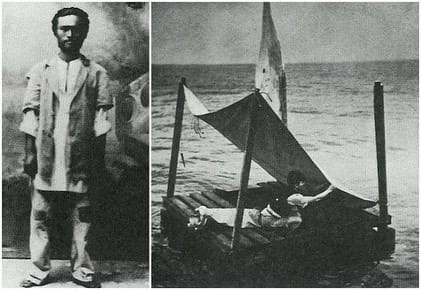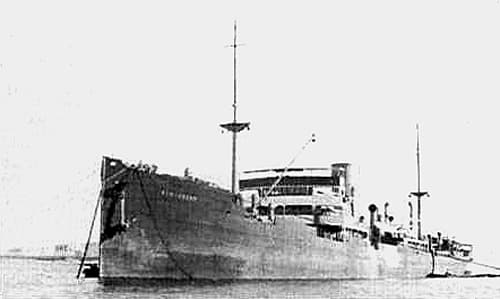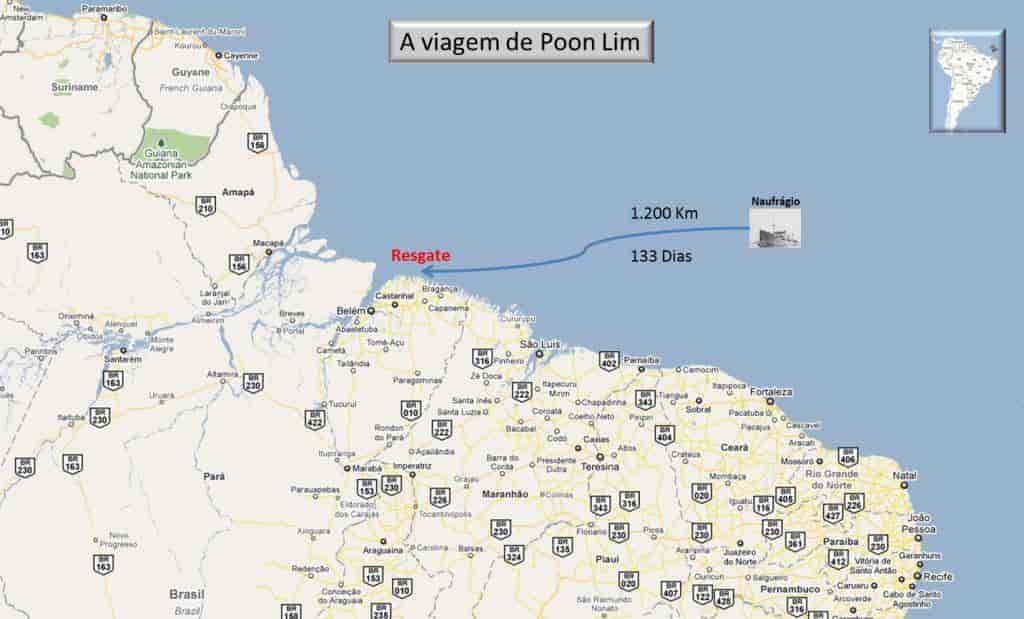Poon Lim: The Remarkable Survival Story of 133 Days at Sea

Poon Lim’s survival story is one of the most extraordinary tales of endurance and human resilience. Stranded in the middle of the Atlantic Ocean during World War II, Lim not only defied the odds but set a record for surviving the longest on a life raft in open water. His resourcefulness and determination allowed him to survive for 133 days on the ocean, relying on creativity and sheer willpower to stay alive.
Who Was Poon Lim?
Born in Hainan, China, in 1918, Poon Lim grew up in a humble family, and like many young men of his generation, he sought opportunities abroad. Lim found work as a steward on British merchant ships during World War II, a dangerous job given the ongoing naval warfare.
In November 1942, Poon Lim was working aboard the British merchant ship SS Benlomond, which was making its way from Cape Town, South Africa, to Suriname. The Atlantic Ocean was a hotspot for German U-boats at the time, and it was during this voyage that his life would take a dramatic turn.


How Did Poon Lim Get Stranded?
On November 23, 1942, Poon Lim’s ship, the SS Benlomond, was torpedoed by a German U-boat off the coast of Brazil. The ship sank quickly, leaving few survivors. Lim was one of them, managing to grab a life jacket before jumping overboard. In the chaos, he found a small wooden life raft stocked with minimal supplies, which would become his home for the next several months.
How Long Was Poon Lim Stranded?
Poon Lim was stranded in the Atlantic Ocean for an astonishing 133 days, from November 23, 1942, to April 5, 1943. During this time, he drifted over 1,000 miles, from the point of the sinking near the coast of Brazil to the waters off the coast of South America.
What Did Poon Lim Do to Survive?
Poon Lim’s survival strategy combined resourcefulness with an unyielding determination to stay alive. Despite having only basic supplies and the vast expanse of the ocean around him, he adapted and improvised to ensure his survival.
1. Using Limited Supplies
The life raft Poon Lim found was stocked with a few supplies, including biscuits, chocolate, some water, and flares. However, these supplies were nowhere near enough for the months he would spend stranded. Lim rationed the food and water carefully, but as they began to dwindle, he knew he had to take matters into his own hands.
2. Fishing and Catching Seabirds
With no land in sight and his initial food supply exhausted, Poon Lim turned to the ocean for sustenance. He fashioned a fishing line using a piece of wire from the life raft and a nail as a hook. Lim managed to catch fish, which became his primary food source. But fishing alone wasn’t enough.
Lim also caught seabirds that occasionally landed on his raft. By using the remains of fish as bait, he attracted birds, which he would then catch, kill, and eat. He even drank their blood to hydrate himself when fresh water ran out, a tactic that may sound grim but was necessary for survival.
3. Harvesting Rainwater
Poon Lim was fortunate to have access to some fresh water when it rained. He used a canvas sail and empty cans to collect rainwater, a method that became essential as his initial water supply was quickly depleted. He was careful to drink small amounts to prevent dehydration, only taking in what was necessary.
4. Resourceful Use of Materials
Poon Lim was inventive with the limited resources at his disposal. He unraveled pieces of the canvas sail to use as fishing lines and constructed a makeshift knife from a biscuit tin, which he used to clean the fish he caught and fend off sharks.
5. Dealing with Sharks
One of the major threats Lim faced were sharks. On more than one occasion, he had to fend off the dangerous predators. When one particularly aggressive shark attempted to attack him, Lim used his fishing line and makeshift tools to protect himself, showing incredible bravery and quick thinking.
6. Maintaining His Mental Strength
Perhaps one of the most challenging aspects of Lim’s ordeal was the mental toll of isolation. Alone for months on end, he had no one to talk to, no rescue in sight, and the ever-present fear of death looming over him. Despite this, Lim maintained his mental strength by keeping a routine and focusing on small tasks, such as fishing and maintaining his raft, to give himself a sense of purpose each day.
7. Flares and Rescue Attempts
Throughout his time stranded, Lim encountered passing ships and planes. He used the flares from his life raft in hopes of signaling for help, but his attempts were in vain. In some cases, ships seemed to ignore his distress signals, and Lim later speculated that they might have feared he was a decoy to lure them into a U-boat trap.
The Miracle of Rescue
On April 5, 1943, Poon Lim’s ordeal came to an end when he was spotted by Brazilian fishermen near the coast of Brazil. They rescued him, and he was taken to a hospital where he was treated for malnutrition and dehydration. Despite the physical toll of his experience, Lim was remarkably healthy, thanks to his careful rationing and resourceful survival tactics.
After 133 days at sea, Poon Lim had survived one of the longest and most dangerous experiences a person can endure. His survival became an international sensation, and he was honored for his bravery and resilience. The British government awarded him the British Empire Medal, and his story became a testament to the power of human endurance.

Legacy of Poon Lim
Poon Lim’s record for the longest time spent surviving on a life raft remains unmatched. His story is not only a tale of survival but also a lesson in human ingenuity, determination, and the will to live. After World War II, Lim emigrated to the United States, where he lived out the remainder of his life, always carrying with him the legacy of his incredible journey.
Today, his survival story continues to inspire people around the world. From seafarers to adventurers, Lim’s experience serves as a powerful reminder of what is possible when one is faced with the harshest conditions.
Poon Lim’s survival in the Atlantic Ocean for 133 days is one of the most remarkable survival stories ever recorded. Faced with unimaginable challenges, from a lack of food and water to constant threats from sharks and isolation, Lim’s ingenuity and willpower allowed him to overcome every obstacle. His story remains a testament to human resilience and continues to inspire people to this day.
FAQ: Poon Lim Survival Story
1. Who was Poon Lim?
Poon Lim was a Chinese sailor who survived for 133 days on a life raft after his ship, the SS Benlomond, was torpedoed by a German U-boat during World War II. His story of survival is one of the most extraordinary tales of human endurance.
2. How long was Poon Lim stranded at sea?
Poon Lim was stranded at sea for 133 days. He was adrift in the Atlantic Ocean from November 23, 1942, until his rescue on April 5, 1943.
3. What did Poon Lim do to survive?
To survive, Poon Lim rationed the limited supplies on his life raft, caught fish and seabirds for food, drank rainwater, and used bird blood when necessary to stay hydrated. He also defended himself from sharks and maintained his mental strength by sticking to daily routines.
4. How did Poon Lim catch food?
Poon Lim used wire from the life raft to create a fishing line and nail for a hook, allowing him to catch fish. He also attracted seabirds by using fish as bait, which he then caught and ate.
5. How did Poon Lim collect water?
Poon Lim used a canvas sail and empty cans to collect rainwater. This was his primary source of drinking water after the initial water supply on the raft ran out.
6. Did Poon Lim encounter sharks?
Yes, Poon Lim encountered sharks during his time at sea. He had to fend them off, particularly when they threatened his raft or his ability to fish.
7. How was Poon Lim rescued?
On April 5, 1943, Poon Lim was rescued by Brazilian fishermen who spotted his life raft near the coast of Brazil. He was taken to a hospital where he received treatment for malnutrition and dehydration.
8. Why didn’t ships or planes rescue Poon Lim earlier?
Poon Lim encountered passing ships and planes during his time stranded, but his flares and distress signals went unnoticed or ignored. He speculated that some ships may have feared that his life raft was a decoy for a U-boat trap.
9. What awards did Poon Lim receive?
Poon Lim was awarded the British Empire Medal by King George VI in recognition of his bravery and incredible survival.
10. Is Poon Lim’s record for survival still unmatched?
Yes, Poon Lim’s record of surviving 133 days on a life raft remains unmatched. His story continues to be an inspiration for survival and human endurance.
11. What was Poon Lim’s legacy after the war?
After World War II, Poon Lim emigrated to the United States, where he lived for the rest of his life. His survival story remains one of the most remarkable accounts of endurance and resourcefulness.
